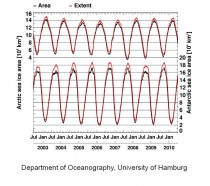By Tom Gantert, Michigan Confidential, Jan. 19, 2011
Arctic sea ice area, 2001-2010A University of Michigan study released Tuesday claims shrinking snow and ice cover intensify global warming. But many skeptics question the conclusions and point to the limited amount of data over time that the researchers had available.
Mark Flanner, an assistant professor at the University of Michigan’s Department of Atmospheric, Oceanic and Space Sciences is the lead researcher. He has analyzed data from satellites over the last three decades in the northern hemisphere.
“The implication is that Earth’s climate may be more sensitive to increases in atmospheric carbon dioxide and other perturbations than models predict,” Flanner said in a press release.
Pat Michaels, a senior fellow in environmental studies at the Cato Institute, said in an e-mail that while many do not dispute that the phenomenon of “greenhouse warming” exists, what is important is the “amount of warming.” He said that it is clearly below what was predicted by the United Nations Intergovernmental Panel on Climate Change.
Roy Spencer, a principal research scientist at University of Alabama-Huntsville, said scientists have only been measuring Arctic sea ice since 1979. He said researchers who start with the conclusion that is a “normal” period for temperatures could not be proven right or wrong.
“That is the mistake everyone makes in this business,” Spencer said. “You can’t prove them wrong. It is one thing to measure what has happened. But to figure out cause and effect is extremely different. Yet, that makes all the difference in the world when determining man-made global warming.”
Thermometer readings in the Arctic suggest that it was just as warm in the 1930s as it is now, he said.
“And it was way warmer in the Arctic thousands of years ago,” he notes. “How did that happen?”
Spencer said the sea’s ice could have melted naturally and that the U-M researchers are assuming it is all due to an increase in the output of carbon dioxide.
He notes that there was a great climate shift in 1977 that warmed Alaska up very quickly and that it would have taken longer for the ocean to catch up to the warmer land masses. It is this that could account for the melting ice.
“These changes are consistent with natural climate variability,” Spencer said.
William Happer, a professor of physics at Princeton University, pointed to a graph of data (below, enlarged here) collected by the Department of Oceanography at the University of Hamburg that showed the Arctic and Antarctic sea ice areas had remained relatively the same from January 2003 through January 2010.

"I am not sure what the University of Michigan authors are looking at, but I don't see much year-to-year ice loss," Happer wrote in an e-mail. "There are lots of models and they predict different things. So you can usually find some model that will predict whatever you have observed. With respect to northern hemisphere sea ice and snow cover, you might note that 30 years ago was the end of the last cooling period, that began around 1940 and had Newsweek running alarming cover studies about the next ice age in the 1970's. So you don't have to have a big computer to guess that there is a bit less snow cover now than 30 years ago."
See post here.




